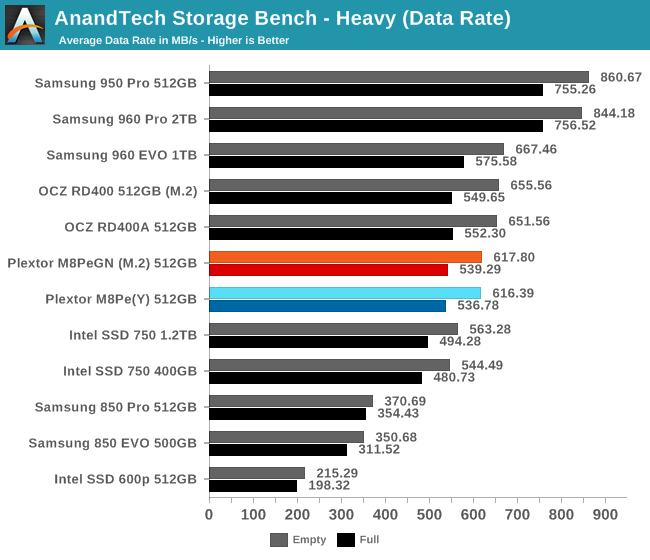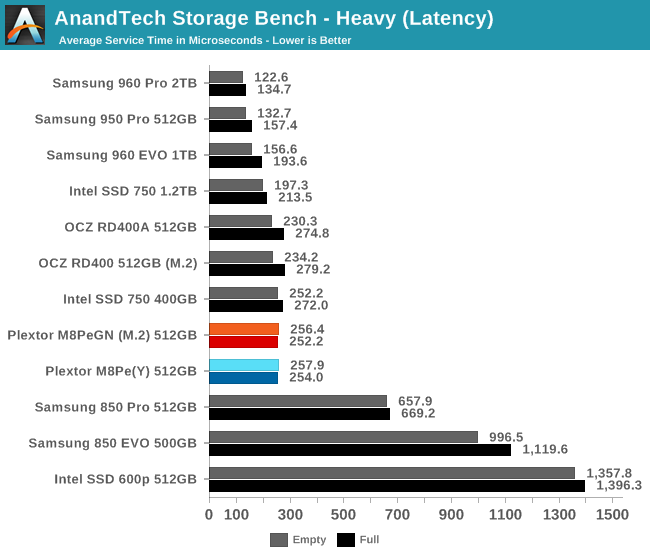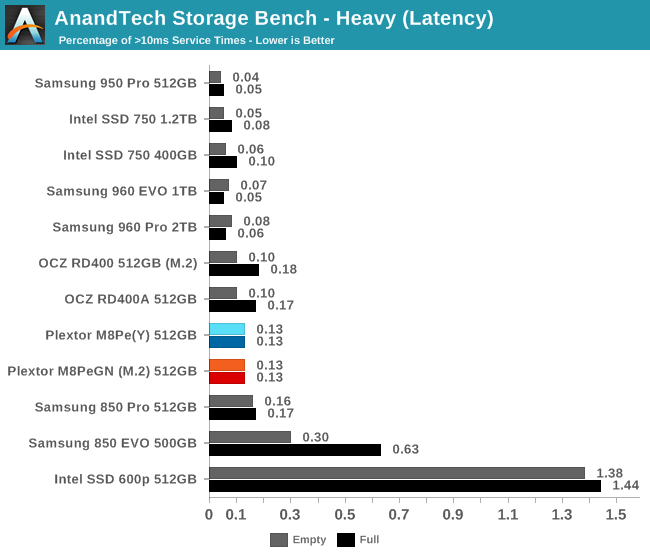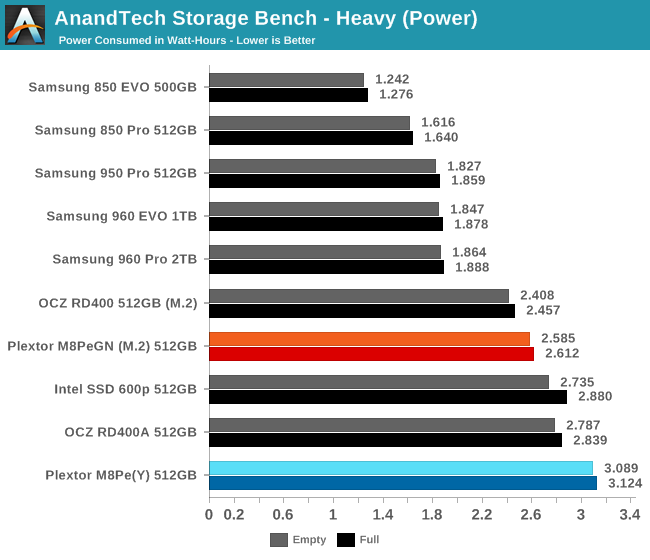The Plextor M8Pe (512GB) SSD Review
by Billy Tallis on December 14, 2016 9:00 AM ESTAnandTech Storage Bench - Heavy
Our Heavy storage benchmark is proportionally more write-heavy than The Destroyer, but much shorter overall. The total writes in the Heavy test aren't enough to fill the drive, so performance never drops down to steady state. This test is far more representative of a power user's day to day usage, and is heavily influenced by the drive's peak performance. The Heavy workload test details can be found here.

On the Heavy test, the Plextor M8Pe can't compete with Samsung's MLC-based PCIe SSDs, but its average data rate is almost as high as the 1TB Samsung 960 EVO, and the 512GB OCZ RD400. The M8Pe is about 66% faster overall than the best SATA SSDs; a smaller margin than for The Destroyer but still substantial.

The average service time if the M8Pe is surprisingly slightly better when the test is run on a full drive than an empty drive. Either way, it doesn't deliver latencies as low as Samsung's PCIe SSDs, but it is close to the rest of the MLC-based PCIe SSDs.

The M8Pe has about twice as many high-latency outliers as the fastest PCIe SSDs, and the SATA-based Samsung 850 Pro is only a little worse off than the M8Pe.

The power consumption of the M8Pe is again worse than any PCIe M.2 drive other than the much slower Intel SSD 600p.










64 Comments
View All Comments
Magichands8 - Wednesday, December 14, 2016 - link
This is amazing! Tiny 128GB SSDs for $0.64/GB! And look at that 1TB for $0.51/GB! We even get to use a crappy Microsoft bundled driver for these! Who knows, in 2017 we may even get to see consumer SSDs reach $0.80, $0.90 or even $1+ per GB... Time doesn't stand still and neither does the endless march of progress. Brace yourselves guys, the future's going to be an amazing place.ironwing - Thursday, December 15, 2016 - link
What is a the reason that PCIe SSDs consume more power than SATA SSDs? Is it simply the higher speeds? The review covered the sleep state issues with the PCIe drives but when the drives are in a similar state, the SATA drives appear to be much more power efficient.Billy Tallis - Thursday, December 15, 2016 - link
I think the biggest problem is that the NVMe power saving states I'm testing don't include reducing the PCIe link speed or width. Keeping a PCIe 3.0 x4 link lit up takes a significant amount of power. The SATA drives by contrast are being told to put the SATA link in a low power state and take that as the signal to engage internal power saving mechanisms.bbhaag - Thursday, December 15, 2016 - link
Thanks for the great review Billy. I've been holding off on buying the Plextor for my new build hoping that Anandtech would put up a review and you guys delivered. Looks like they are solid drives at a mediocre price point. I knew I should have bought the 512 version when the egg had it for 179...sigh...oh well I can wait.DigitalFreak - Thursday, December 15, 2016 - link
$50 price difference for a heatsink? Really?Bruce427 - Friday, December 16, 2016 - link
I think that price includes a PCIe card as well.Bruce427 - Friday, December 16, 2016 - link
At first glance at published specks, it appears that the New Corsair MP500 NVMe drive may outperform the PlextorM8Pe for about the same price.Bruce427 - Friday, December 16, 2016 - link
Sorry, spell check got me. That should have been "specs."Bruce427 - Friday, December 16, 2016 - link
"specs"Billy Tallis - Friday, December 16, 2016 - link
The Corsair MP500 uses the Phison E7 controller. Next week I should have a review up of the Patriot Hellfire that is essentially the same drive. It's slower than the M8Pe on almost every test.